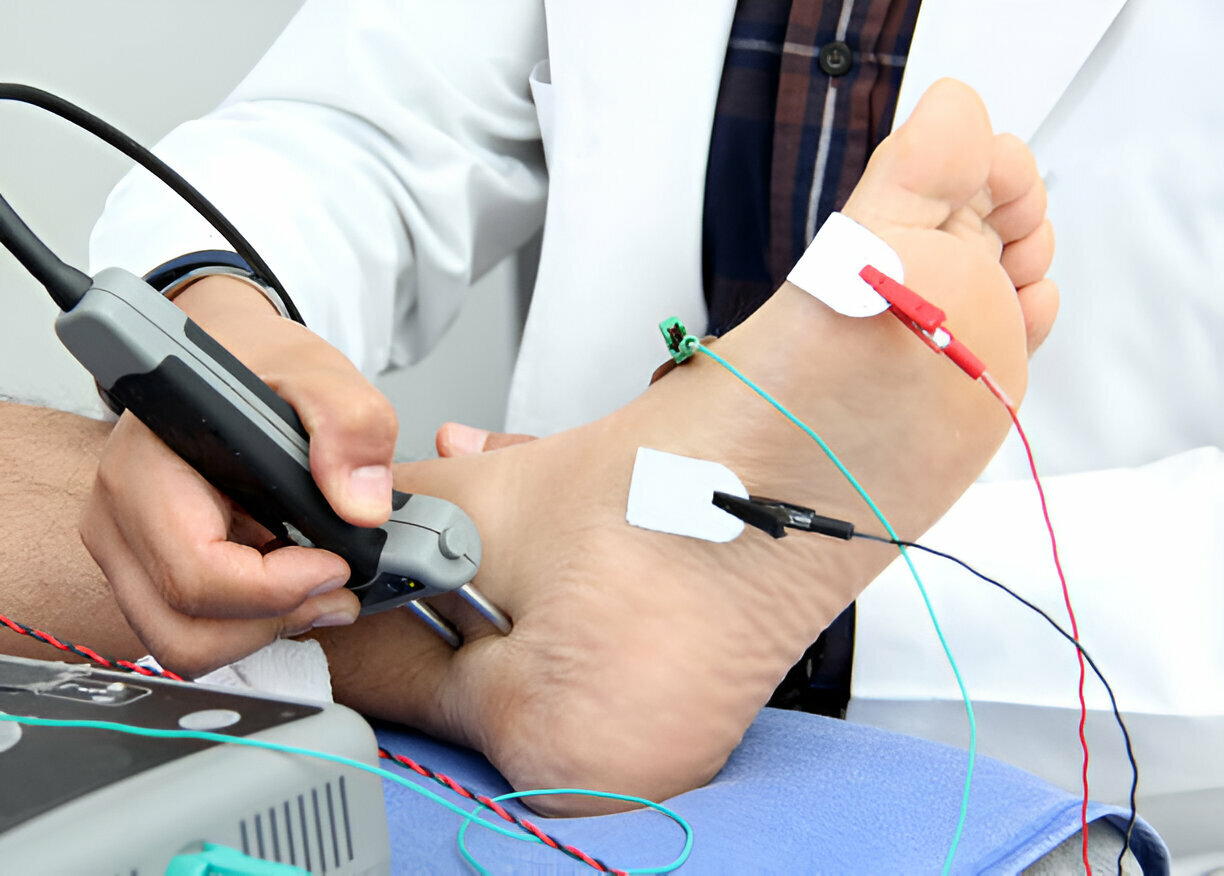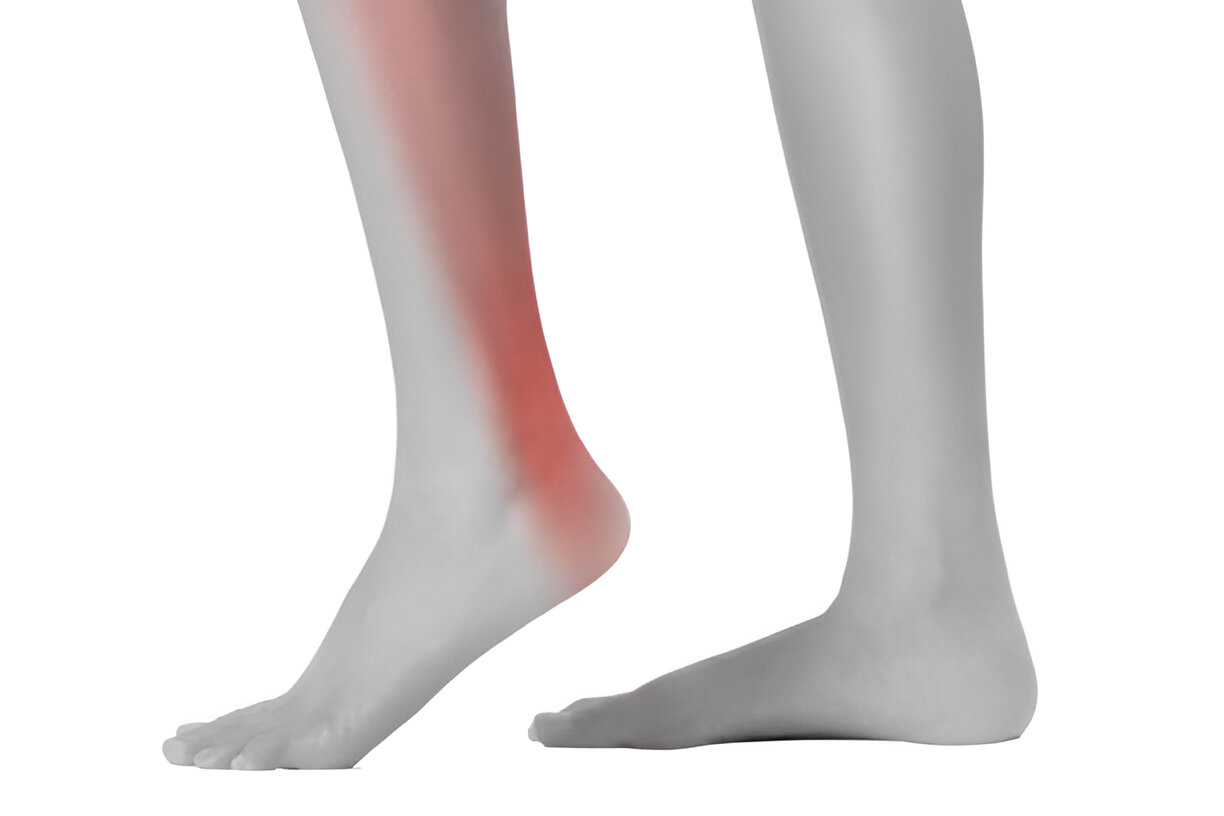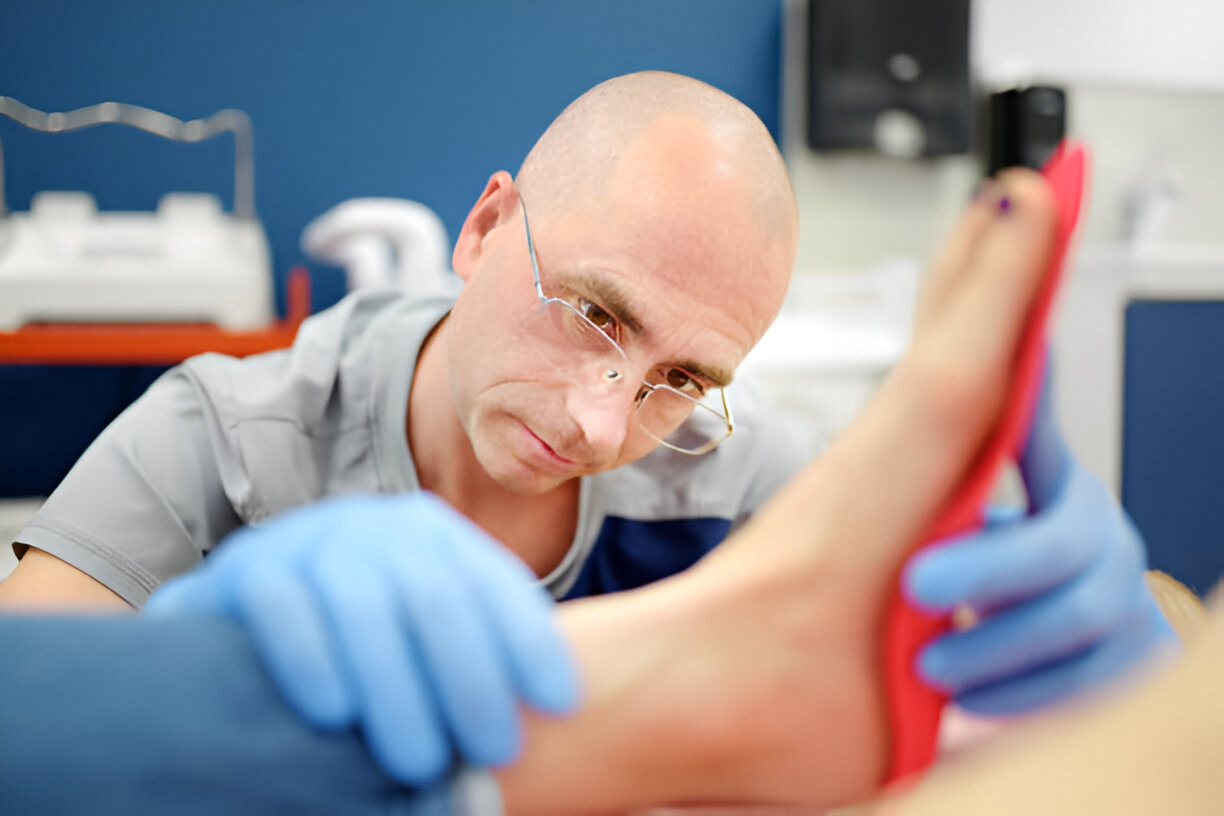

Diabetes is a condition that requires constant care, and that includes your feet. For those living with diabetes in Calgary, maintaining foot health isn’t just about comfort; it’s essential for preventing serious complications like infections and amputations. Many residents turn to local podiatrists at trusted foot and ankle clinics for specialized diabetic foot care.
High blood sugar levels can lead to nerve damage (diabetic neuropathy), which reduces your ability to feel pain, heat, or injury. Without sensation, even small cuts or blisters can go unnoticed and untreated, turning into serious infections. Diabetes also reduces blood flow to your feet, slowing the healing process.
Common issues include:
Neuropathy: Loss of sensation can lead to unnoticed injuries.
Ulcers: Open sores that can easily become infected.
Peripheral Artery Disease (PAD): Poor circulation that complicates healing.
These issues can escalate quickly, but early intervention and regular care from a podiatrist can make all the difference.
Podiatrists are foot and ankle specialists who are key to managing diabetes-related foot problems. These professionals offer:
They also use advanced tools to monitor nerve health and circulation and provide professional wound care, callus debridement, and ulcer treatment. Regular visits ensure problems are caught early before they become emergencies.
Calgarians appreciate the convenience and community-focused care of local foot and ankle clinics. Local podiatrists:
Patients are more likely to stick with care plans when they trust their provider and can easily access services. Local clinics also build long-term relationships with their patients, ensuring continuity of care.
Trusted foot and ankle clinics in Calgary offer a full range of services designed for diabetic foot care, including:
Routine Exams: To identify changes in skin, circulation, or nerve sensitivity.
Wound and Ulcer Care: Advanced treatments to promote healing and prevent infections.
Custom Orthotics: To relieve pressure and improve function.
Diabetic Footwear Guidance: Ensuring patients wear protective, well-fitting shoes.
Surgical Interventions: If necessary, for issues like hammertoes or bunions.
Education and Support: Guidance on daily care routines and lifestyle adjustments.
These clinics offer both preventive and corrective care, helping patients stay ahead of potential issues.
Routine check-ups are a cornerstone of diabetic care. During these visits, podiatrists:
Even if you don’t feel pain, subtle signs of damage can indicate larger issues. Regular exams help catch these early, reducing the need for invasive treatments later.
In addition to seeing a podiatrist, there are several things you can do at home to keep your feet healthy:
Inspect your feet daily: Look for cuts, blisters, swelling, or colour changes.
Wear proper shoes: Avoid walking barefoot and choose footwear that supports and protects.
Keep feet clean and moisturized: Prevent cracks and infections.
Control blood sugar levels: Stable glucose reduces nerve damage risk.
Never ignore pain or injury: Seek medical help promptly.
Combining professional care with these simple habits dramatically lowers your risk of serious complications.
If you’re living with diabetes, your feet need just as much attention as your diet or blood sugar levels. Working with a local podiatrist in Calgary ensures you receive expert, individualized care close to home.
From routine check-ups to advanced wound care, Calgary’s trusted clinics provide the support you need to stay healthy, active, and independent.
Book an appointment with us today. Don’t wait for symptoms to appear—proactive foot care can prevent complications and keep you moving comfortably. Contact our trusted clinic to begin your journey to better diabetic foot health.

A sprained ankle is a common yet potentially serious injury that involves the stretching or tearing of ligaments supporting the ankle joint. Whether you’re an athlete, an active individual, or someone who missteps on an uneven surface, a sprained ankle can happen to anyone. Recognizing the symptoms early and seeking timely medical attention can significantly impact your recovery and prevent long-term complications.
A sprained ankle occurs when the foot twists, rolls, or turns beyond its normal range of motion, causing damage to the surrounding ligaments. Common causes include sudden movements during sports, walking on an unstable surface, or missing a step while climbing stairs.
The most common symptoms include:
Understanding these symptoms is crucial, as they can help you determine whether immediate medical attention is necessary. If you experience significant pain, swelling, or difficulty walking, it’s best to consult a professional for proper diagnosis and treatment.
While mild sprains may heal with rest and home care, seeking a professional diagnosis is essential to rule out fractures, severe ligament tears, or other complications. Many people underestimate their injuries, leading to prolonged pain, chronic instability, and an increased risk of re-injury.
Podiatrists specialize in diagnosing and treating foot and ankle injuries. A thorough evaluation typically includes:
Physical Examination: Checking for tenderness, swelling, and range of motion.
Imaging Tests: X-rays, MRIs, or ultrasounds to assess ligament damage and rule out fractures.
By getting a professional diagnosis, you ensure your injury is treated appropriately and follow the best course of action for a full recovery.
When dealing with a sprained ankle, consulting a podiatrist provides several advantages. They are highly trained specialists in foot and ankle conditions, making them the best resource for tailored treatment plans.
Some of the benefits of consulting a podiatrist include:
Expertise in Foot and Ankle Care: Their in-depth knowledge of biomechanics ensures optimal recovery.
Access to Advanced Treatments: Specialized treatments like custom orthotics, physical therapy, or minimally invasive procedures.
Multidisciplinary Care: Collaboration with physical therapists and orthopedic specialists for a holistic recovery plan.
Treatment for a sprained ankle depends on its severity. Podiatrists in Calgary typically follow a structured approach:
Initial Care: Following the RICE method (Rest, Ice, Compression, Elevation) to manage swelling and pain.
Pain Management: Over-the-counter pain relievers or prescribed medications if necessary.
Physical Therapy: Exercises to restore strength, flexibility, and balance.
Bracing or Taping: To support the ankle and prevent further injury.
Surgical Intervention (in severe cases): If ligaments are completely torn and require repair.
By following a structured plan, foot doctors in Calgary ensure patients recover effectively and reduce their risk of future problems.
One of the key advantages of visiting a podiatrist is access to state-of-the-art diagnostic tools. Traditional X-rays help detect fractures, but advanced imaging techniques such as ultrasound and MRI scans provide a detailed view of soft tissues, including ligaments and tendons.
These imaging techniques help podiatrists:
With these advanced diagnostic tools, podiatrists can create a precise treatment plan tailored to your injury.
Failing to seek proper treatment can lead to long-term complications. Some of the risks include:
Chronic Instability: Weak ligaments increase the likelihood of future sprains.
Joint Arthritis: Repeated injuries can lead to arthritis and chronic pain.
Persistent Pain: Untreated sprains may cause lingering discomfort and mobility issues.
By consulting a foot doctor in Calgary, you can prevent these complications and ensure your ankle heals properly.
Rehabilitation is a crucial step in recovering from a sprained ankle. Foot doctors guide patients through structured recovery plans, which include:
Range of Motion Exercises: To restore flexibility.
Strengthening Exercises: To build stability.
Balance Training: To prevent future sprains.
Gradual Return to Activity: A supervised return to normal activities, including sports.
A well-planned rehabilitation program reduces recovery time and prevents re-injury.
Once you’ve recovered from a sprained ankle, taking steps to prevent future injuries is essential. Foot doctors recommend:
Strengthening Exercises: Building strong muscles for support.
Wearing Proper Footwear: Supportive shoes reduce the risk of sprains.
Using Braces When Needed: Helpful for athletes or those prone to injuries.
Practicing Balance Exercises: Yoga and stability training can improve joint control.
These preventive measures can significantly lower your chances of experiencing another sprain.
While many sprains can be treated by a podiatrist, some require urgent medical attention. Seek emergency care if:
Recognizing these signs ensures you receive timely intervention for a serious injury.
Selecting a qualified foot doctor is essential for effective treatment. Consider factors like:
Specialization: Choose podiatrists with experience in sports injuries and ankle care.
Patient Reviews: Look for highly rated professionals with positive testimonials.
Comprehensive Services: Opt for clinics offering physical therapy, custom orthotics, and advanced treatments.
By choosing a reputable podiatrist, you can ensure expert care and a smooth recovery.
A sprained ankle may seem like a minor injury, but without proper care, it can lead to long-term issues. Consulting foot doctors in Calgary ensures accurate diagnosis, effective treatment, and guided rehabilitation. If you or a loved one has suffered an ankle sprain, don’t wait—schedule an appointment with a Calgary podiatrist today to start your journey to recovery.
Don’t let an ankle sprain slow you down! Consult our foot doctors in Calgary today to ensure a swift recovery and prevent future injuries. Schedule your appointment now!

Ankle pain is a prevalent health issue affecting individuals of all ages and activity levels. Whether you are an athlete or someone who enjoys leisurely walks, understanding the causes and treatments for it can enhance your quality of life. Podiatrists play a crucial role in diagnosing and managing this condition. Their expertise ensures tailored solutions that restore mobility and comfort.
Ankle pain can arise from various conditions, including:
Sprains and Strains: These injuries occur when ligaments or muscles are overstretched, often due to sudden twisting or rolling of the ankle.
Fractures: Trauma can cause bone fractures, leading to severe pain and swelling, requiring immediate medical attentionTendonitis: Overuse can result in inflamed tendons, which are common among athletes and active individuals.
Arthritis: Osteoarthritis and rheumatoid arthritis can cause joint pain, stiffness, and swelling, often requiring long-term management.
Achilles Tendon Injuries: Damage to the Achilles tendon can limit mobility and cause significant discomfort.
Bursitis: Inflammation of the fluid-filled sacs (bursae) around the joint can result from repetitive motion or excessive pressure.
Early diagnosis is essential for effective treatment. Common symptoms include:
Swelling: Fluid buildup around the joint, often signalling injury or inflammation.
Bruising: Discoloration due to trauma, indicating possible ligament damage or fractures.
Stiffness: Limited range of motion, often associated with arthritis or tendonitis.
Pain and Tenderness: Persistent pain when moving or bearing weight suggests an underlying issue.
Instability: Weakness or difficulty balancing may indicate ligament damage or chronic conditions.
Consulting a podiatrist is recommended if you experience:
To accurately assess ankle pain, podiatrists use:
Physical Examination: Assessing range of motion, swelling, and tenderness.
X-rays: Detecting fractures and joint abnormalities.
MRI Scans: Providing detailed images of soft tissue injuries.
Ultrasound: Identifying tendon or ligament damage in real-time.
Gait Analysis: Evaluating walking patterns to detect biomechanical issues.
Many ankle pain conditions can be managed without surgery. Common treatments include:
Rest and Ice: Reduce swelling and inflammation by limiting activity and applying ice packs.
Compression and Elevation: Using bandages for support and keeping the foot elevated to minimize swelling.
Physical Therapy: Strengthening muscles, improving flexibility, and restoring mobility.
Medications: Over-the-counter pain relievers like ibuprofen can reduce pain and inflammation.
Orthotic Devices: Custom insoles and braces provide additional support and stability.
When conservative treatments are ineffective, surgical options may be necessary, including:
Arthroscopy: Minimally invasive procedure to remove damaged cartilage or repair ligaments.
Ankle Fusion: Fusing bones to alleviate arthritis-related pain and improve stability.
Ligament Reconstruction: Restoring stability after repeated sprains.
Tendon Repair: Addressing severe tendon damage or ruptures.
Preventive measures can significantly reduce the risk of ankle pain:
Wear Proper Footwear: Choose supportive shoes with good cushioning.
Warm-Up Before Activities: Stretching prepares the muscles and joints for movement.
Strengthen Ankles: Regular exercises targeting the calf and ankle muscles enhance stability.
Maintain Flexibility: Stretching exercises improve the range of motion and prevent stiffness.
Listen to Your Body: Avoid pushing through pain and allow time for recovery.
Selecting a qualified podiatrist ensures effective treatment. Consider the following when choosing a specialist:
Check Credentials: Ensure they are board-certified and experienced in treating ankle conditions.\
Read Reviews: Patient testimonials provide insight into the quality of care.
Specialization: Choose a podiatrist with expertise relevant to your condition.
Consultation: An initial meeting can help assess their approach to treatment.
Communication Style: A good podiatrist listens to your concerns and explains treatment options clearly.
Ankle pain can impact daily activities, but with the right care, recovery is possible. Understanding the causes, symptoms, and treatment options empowers individuals to take proactive steps toward relief. Consult us for expert diagnosis and tailored treatment to regain mobility and comfort. Whether through preventive measures or medical intervention, addressing pain early can lead to better long-term outcomes.

Foot pain can greatly impact your daily life, making simple activities like walking uncomfortable and restricting mobility. While some discomfort may be short-term, ongoing pain could indicate underlying issues that need professional attention. In this article, we'll explore the common causes of foot pain, when to seek professional help, and the role of a foot care clinic in diagnosing and treating your symptoms.
Foot pain can arise from various factors, including structural issues and lifestyle choices. Some common causes are:
Bunions and Hammertoes: Bunions are painful bony bumps that form at the base of the big toe, while hammertoes cause toes to bend, leading to discomfort and difficulty finding appropriate shoes.
Flat Feet or High Arches: Both conditions can cause improper weight distribution across the foot, leading to pain when walking or standing for extended periods.
Tendinitis: Tendon inflammation, such as Achilles tendinitis, can cause pain at the back of the heel and is often linked to overuse or improper footwear.
Recognizing these symptoms can help you understand the source of your discomfort. If you're experiencing persistent pain, it may be time to consult a foot care clinic.
Not all foot pain requires a visit to a clinic, but certain signs indicate that professional care is necessary:
Swelling and Redness: Swelling, redness, or warmth may be signs of an infection or inflammatory condition, which requires immediate medical attention.
Difficulty Walking: Struggling to walk or bear weight on your foot can suggest structural issues or severe inflammation that needs professional treatment.
Changes in Shape: Deformities like bunions or hammertoes should be assessed early to prevent long-term complications.
Numbness or Tingling: Loss of sensation or abnormal feelings in the feet can indicate nerve problems that require further investigation.
If you experience any of these symptoms, it's important to visit a clinic for a diagnosis and a personalized treatment plan.
They specialize in diagnosing and treating a wide range of conditions. Here's what you can expect during your visit:
Advanced Diagnostic Techniques: Many clinics use tools like X-rays, ultrasound imaging, or 3D scanning to get a detailed look at your condition and ensure accurate diagnosis.
Personalized Treatment Plans: Based on your assessment, the specialist will create a treatment plan that may include orthotics, physical therapy, or medication. If necessary, they may refer you to a podiatrist for further care.
Prevention and Education: Clinics emphasize teaching patients how to prevent future problems through proper footwear, stretching exercises, and lifestyle modifications.
When you visit a foot care clinic, you'll have access to various treatment options tailored to your specific condition:
Custom Orthotics: These specially designed shoe inserts provide support and improve alignment to alleviate pain.
Physical Therapy: A physical therapist can create an exercise program to strengthen the muscles in your feet and improve flexibility.
Medication: Anti-inflammatory medications or corticosteroid injections may be used to manage pain and reduce inflammation.
Surgery: In severe cases, surgery may be required to address structural deformities or significant injuries.
Education: These clinics also provide education on maintaining foot health and preventing future issues, including advice on footwear and daily care routines.
Prevention is often more effective than treatment. Here are some tips to help maintain healthy feet:
Choose Proper Footwear: Invest in shoes that provide good support and fit well. Avoid wearing high heels or shoes that pinch your toes.
Practice Good Hygiene: Keep your feet clean and dry to avoid infections. Regularly check for changes like blisters, calluses, or discoloration.
Stay Active: Regular physical activity helps maintain a healthy weight and strengthens the muscles in your feet.
Stretch and Strengthen: Regularly stretch and exercise your feet and ankles to improve flexibility and prevent injuries.
Be Mindful of Activities: Ensure you warm up properly before exercise and wear the right footwear to prevent injuries.
By following these preventive measures, you can minimize the risk of pain and maintain the health of your feet.
Routine visits to a foot care clinic can significantly improve your overall health by:
Improved Mobility: Addressing pain allows you to move comfortably, leading to a more active and healthier lifestyle.
Holistic Health Management: Foot problems can be linked to other health conditions, such as diabetes or arthritis. Regular visits help manage these connections effectively.
Personalized Care: A clinic will provide a plan tailored to your unique needs, leading to better outcomes and satisfaction.
Education: Ongoing visits ensure you stay informed about foot health, empowering you to take proactive steps for long-term wellness.
When selecting a clinic, consider the following factors:
Range of Services: Choose the one that offers a comprehensive range of services, including diagnostic testing, treatment options, and rehabilitation.
Patient Reviews: Check online reviews or ask for recommendations to gauge patient satisfaction and care quality.
Convenience: Choose one that is convenient in terms of location and operating hours.
Insurance: Verify that it accepts your insurance or offers flexible payment plans.
By taking the time to do your research, you can ensure you receive the best possible care for your foot health.
Foot pain shouldn't limit your mobility or quality of life. Understanding the causes, knowing when to seek professional help, and utilizing the services of a foot care clinic are crucial steps toward achieving pain-free walking. If you're experiencing pain, don't wait. Visit a clinic to receive expert care and regain your comfort.
Take the First Step Toward Pain-Free Walking
Ready to walk pain-free? Contact our foot clinic in Calgary today to schedule your appointment and start your journey toward healthier feet and improved mobility!

Fungal toenails, also known as onychomycosis, is a common condition that impacts the appearance and health of your toenails. This infection is caused by various fungi that thrive in warm, moist environments, often found in public places like showers, pools, and locker rooms. When these fungi take hold, they can cause your toenails to become discoloured, thick, and brittle, making them unsightly and potentially painful.
It can be a persistent and stubborn issue, and attempting to treat it yourself may not yield the best results. This is where a podiatrist, a medical expert specializing in the diagnosis and treatment of foot and ankle conditions, can make an immense difference.
Weak immune system: Individuals with compromised immune systems, such as those with diabetes, HIV, or certain medications, are more susceptible to fungal infections.
Poor circulation: Reduced blood flow to the feet can make it harder for the body to fight infections.
Repeated exposure: Frequent exposure to public areas with warm, moist environments, such as communal showers or swimming pools, increases the risk of contracting an infection.
Injury to the nail: Trauma or damage to the toenail can create an entry point for fungal organisms.
Genetics: Some people may be more predisposed to developing fungal toenails due to their genetic makeup.
Although over-the-counter antifungal treatments may provide temporary relief, they often don't eliminate the fungus, leading to recurring infections. However, consulting a podiatrist provides a more comprehensive and effective approach to treating fungal toenails.
Podiatrists have specialized training and expertise in diagnosing and treating foot and ankle conditions. They can accurately identify the type of fungus causing the infection and recommend the most appropriate treatment plan to address the root cause of the problem.
Accurate Diagnosis: A podiatrist can perform a thorough examination and, if necessary, conduct tests to determine the specific type of fungus causing the infection, ensuring the most effective treatment plan.
Personalized Treatment: Podiatrists can customize the treatment to suit your individual needs, considering factors such as the severity of the infection, your overall health, and any underlying conditions contributing to the issue.
Faster Recovery: With the right treatment approach, you can expect faster and longer-lasting results in clearing up the infection, reducing the risk of recurrence.
Improved Appearance: Successful treatment can help restore the appearance of your toenails, improving their overall health and appearance.
Pain Relief: In some cases, the infection can cause discomfort or pain. Proper treatment can help relieve these symptoms and improve overall quality of life.
Medical History: The podiatrist will ask about your medical history, underlying conditions, and medications or treatments you may have tried previously.
Physical Examination: The podiatrist will thoroughly examine your feet and toenails, looking for signs of infection and assessing the severity of the condition.
Diagnostic Tests: If necessary, the podiatrist may perform additional tests, such as a fungal culture or a biopsy, to confirm the diagnosis and identify the specific type of fungus.
Treatment Plan: Based on the findings, the podiatrist will develop a personalized treatment plan that may include topical or oral antifungal medications, laser therapy, or other specialized treatments.
Follow-up Care: The podiatrist will provide guidance on how to care for your feet during the treatment process and schedule follow-up appointments to monitor your progress and ensure the infection is fully resolved.
Topical Medications: These are applied directly to the affected toenail and can help gradually clear the infection.
Oral Medications: Taken in pill form, these medications work systemically to target the fungus and clear the infection from the inside.
Laser Therapy: Advanced laser treatments can effectively eliminate the fungus by targeting it with concentrated light energy.
Surgical Removal: In severe cases, the podiatrist may recommend removing the affected toenail to allow for a new, healthy nail to grow in its place.
The specific treatment plan recommended by your podiatrist will depend on the severity of your condition, your overall health, and your response to the various treatment options.
Practice Good Foot Hygiene: Keep your feet clean and dry, especially between the toes, to discourage the growth of fungi.
Wear Protective Footwear: Wear shoes or sandals in public areas like locker rooms, pools, and showers to minimize exposure to fungal organisms.
Maintain Proper Nail Trimming: Carefully trim your toenails straight and avoid cutting them too short, as this can create an entry point for fungi.
Disinfect Nail Clippers: Thoroughly clean and disinfect your nail clippers after each use to prevent the spread of fungal infections.
Monitor for Early Signs: Be vigilant for any changes in the appearance of your toenails, such as discoloration or thickening, and seek prompt treatment if you suspect a fungal infection.
In conclusion, seeking professional treatment from a podiatrist is the most effective way to address fungal toenail infections. By taking advantage of the specialized expertise and advanced treatment options, you can expect faster, more reliable results and a lasting solution to this common foot health issue. Don't let this condition hold you back – take control of your foot health and schedule a consultation at a reputable podiatry clinic near you today.
If you're struggling with unsightly and uncomfortable fungal toenails, don't hesitate to schedule an appointment with us. We can provide the specialized care and personalized treatment plan you need to get your feet back to their healthy, happy state. Take the first step towards clear, beautiful toenails by contacting us today.

The Achilles tendon is the largest and strongest in the human body, connecting the calf muscles to the heel bone. Achilles tendonitis is a common overuse injury that occurs when this tendon becomes inflamed or degenerated. It is a painful condition that can significantly impact your mobility and quality of life if left untreated.
It develops gradually over time due to repetitive stress or strain on the tendon. It is commonly seen in athletes, particularly those participating in high-impact sports like running, jumping, or basketball. However, it can also affect less active individuals, especially as they age.
Several factors can contribute to the development of Achilles tendonitis, including:
Overuse and Overtraining: Engaging in excessive or high-intensity physical activity without adequate rest and recovery can strain the Achilles tendon, resulting in inflammation and degeneration.
Sudden Increase in Activity: Rapidly increasing the duration, frequency, or intensity of your physical activity, such as suddenly ramping up your running mileage or trying a new sport.
Improper Footwear: Wearing shoes with inadequate support or cushioning, or shoes that are worn out, can increase stress on the tendon during physical activity.
Biomechanical Factors: Structural issues such as flat feet, high arches, or leg length discrepancies can disrupt the body's natural weight and force distribution, increasing strain on the Achilles tendon.
Age: As you age, the Achilles tendon becomes less flexible and more prone to degeneration, increasing the risk.
Certain Medical Conditions: Conditions like rheumatoid arthritis, diabetes, or obesity can increase its risk by affecting the health and function of the tendon.
The primary symptoms of Achilles tendonitis include:
Pain and Discomfort: You may experience dull, aching pain along the back of the heel and lower leg, especially during or after physical activity.
Stiffness: The Achilles tendon may feel stiff, particularly in the morning or after periods of inactivity.
Swelling and Tenderness: The surrounding area may appear swollen and sensitive to the touch.
Decreased Range of Motion: You may have difficulty flexing or pointing your foot due to the pain and stiffness.
Weakness and Instability: The Achilles tendon may feel weaker, making it difficult to push off or bear weight on the affected leg.
Ignoring Achilles tendonitis can have serious consequences for your health and well-being. If left untreated, the condition can progress and lead to the following complications:
Chronic Pain and Discomfort: Persistent inflammation and degeneration can result in chronic, debilitating pain that interferes with your daily activities and quality of life.
Increased Risk of Rupture: The Achilles tendon can weaken over time, making it more prone to partial or complete tears serious and debilitating injuries that require surgery and a lengthy recovery period.
Altered Gait and Mobility: The pain and stiffness can cause you to alter your walking or running gait, potentially leading to further musculoskeletal problems, such as knee, hip, or back pain.
Reduced Physical Activity and Fitness: When left untreated, it can severely limit your ability to engage in physical activity, leading to a decline in overall fitness and cardiovascular health.
Increased Risk of Other Injuries: Compensating for the Achilles tendon injury by altering your movement patterns can increase the risk of developing other overuse injuries, such as plantar fasciitis.
Permanent Damage: If the condition progresses, it can undergo structural changes, including thickening, scarring, and calcification, potentially resulting in permanent impairment and loss of function.
Fortunately, Achilles tendonitis can be effectively treated with a combination of conservative and, in some cases, surgical interventions. The specific treatment approach will depend on the severity of your condition and the underlying cause. Common treatment options include:
Rest and Activity Modification: Reducing or temporarily stopping the activities that aggravate your problem can help reduce inflammation and allow healing.
Ice and Anti-Inflammatory Medications: Applying ice to the affected area and taking over-the-counter anti-inflammatory medications can help alleviate pain and swelling.
Stretching and Strengthening Exercises: Gentle stretching and targeted strengthening exercises can help improve flexibility, stability, and overall tendon health.
Orthotic Devices: Specialized shoe inserts or braces can help support the Achilles tendon and correct any underlying biomechanical issues.
Physical Therapy: A physical therapist can provide a comprehensive rehabilitation program, including manual therapy techniques, exercises, and other modalities to address the root causes.
Injection Therapy: In some cases, your healthcare provider may recommend corticosteroid or platelet-rich plasma (PRP) injections to help reduce inflammation and promote healing.
Surgery: If conservative treatments are unsuccessful, surgery may be necessary to repair or reconstruct the Achilles tendon in severe or chronic cases.
Ignoring Achilles tendonitis can have serious consequences, leading to chronic pain, reduced mobility, and an increased risk of more severe injuries. Early diagnosis and prompt treatment are crucial for preventing the progression of this condition and avoiding long-term complications.
By recognizing the causes, symptoms, and potential risks, you can take proactive measures to address the issue and protect your overall health and well-being. Remember, addressing the problem at the first signs of discomfort can help you avoid the more severe consequences and get you back to your active lifestyle as quickly as possible.
If you are experiencing persistent or worsening Achilles tendon pain, don't wait - schedule an appointment with us today. Early intervention can make all the difference in your recovery and long-term well-being.

Your feet are the foundation of your body, carrying you through life's daily activities. However, when foot problems arise, they can significantly impact your overall well-being and quality of life. From bunions to plantar fasciitis, many individuals struggle with various issues that can cause pain, discomfort, and even mobility challenges.
Recognizing the importance of addressing these problems is the first step towards achieving long-term foot health. By understanding the underlying causes and seeking professional help, you can take proactive measures to alleviate your woes and enjoy a pain-free future.
When it comes to foot problems, attempting to self-diagnose and treat the issue can often lead to further complications. While some minor ailments may be manageable with simple home remedies, more complex or persistent problems require the expertise of a qualified healthcare professional – a podiatrist.
A podiatrist is a medical specialist who focuses on diagnosing, treating, and preventing foot and ankle-related conditions. These highly trained professionals possess the knowledge and skills to identify the root causes of your problems and develop customized treatment plans to address them effectively.
In Calgary, there is access to a wide range of podiatric services designed to cater to your specific foot health needs. From comprehensive examinations and advanced diagnostic techniques to the latest treatment options, a skilled podiatrist in Calgary can provide you with the personalized care you deserve.
One of the primary culprits behind many foot problems is ill-fitting or inappropriate footwear. Shoes that are too tight, too loose, or lack adequate support can lead to a variety of issues, including:
When you visit a foot doctor, they will conduct a thorough examination to identify the underlying cause of your problems. This may involve a combination of physical assessments, imaging tests, and gait analysis. Based on their findings, they will create a tailored treatment plan designed to address your unique concerns effectively.
Depending on the nature of your condition, the podiatrist's recommendations may include:
By working closely with a foot doctor, you can find relief from your pain and regain your active lifestyle.
Just as you visit your primary care physician for routine check-ups, scheduling regular appointments with a podiatrist is equally important. These visits allow the healthcare professional to monitor the health of your feet, identify any emerging issues, and implement preventive measures to maintain your foot’s well-being.
Choosing a reputable podiatrist in Calgary can provide you with a range of benefits, including:
In addition to seeking professional help from a foot doctor, there are several proactive steps you can take to maintain the health of your feet:
By incorporating these preventive measures into your daily routine, you can significantly reduce your risk of developing problems and enjoy a pain-free, active lifestyle.
Your feet are the foundation of your body, and taking care of them should be a top priority. By understanding the role of a podiatrist and the common foot problems caused by improper footwear, you can take proactive steps to address any issues and maintain your foot health.
Don't let foot pain hold you back. Schedule an appointment with us today and take the first step towards a pain-free future.

Orthotics have become an increasingly popular solution for individuals dealing with various foot and ankle conditions. These custom-made inserts are designed to provide targeted support, alignment, and cushioning to alleviate pain and improve overall foot health. However, one common question that arises is, "How long do orthotics last?" In this comprehensive blog, we'll explore the factors that affect their longevity and provide you with valuable insights to ensure your investment in them lasts for years to come.
These are specialized devices that are custom-made to fit your feet. They are designed to address specific foot conditions, such as:
These custom-fitted inserts are typically made from various materials, including rigid plastics, soft foams, and even carbon fibre, depending on your individual needs and the condition being treated.
They work by providing targeted support, cushioning, and alignment to your feet. They can help to:
The lifespan of your orthotics can vary depending on several factors, including:
It's important to be aware of the signs that indicate these inserts may need to be replaced. These include:
If you notice any of these signs, it's best to consult with your foot care specialist to determine if it's time to replace them.
To extend the life of your orthotics, it's essential to follow proper care and maintenance practices. This includes:
By following these simple steps, you can help to ensure these inserts continue to provide the support and comfort you need for years to come.
Working with a reputable foot clinic can play a vital role in extending the life of your orthotics. Foot clinics can provide the following services:
By working with a reputable foot clinic, you can maximize their longevity and effectiveness, ultimately investing in the long-term health and well-being of your feet.
Orthotics can be a valuable tool in managing various foot and ankle conditions, but their longevity is not indefinite. By understanding the factors that affect their lifespan, following proper care and maintenance practices, and working with a reputable foot clinic, you can maximize the benefits of your investment in foot health.
Remember, the key to long-lasting orthotics is finding the right solution for your individual needs and working closely with your foot care specialist to ensure they continue to provide the support and comfort you require.
If you're in the Calgary area and looking for a reputable foot clinic in Calgary to help you find the perfect orthotics for your needs, consider scheduling a consultation with our team of experienced professionals. We'll work closely with you to create a customized solution that provides the long-lasting support and relief you deserve. Contact us today to take the first step toward optimal foot health.

Your feet are the foundation of your body, supporting your weight and enabling you to move freely. However, a variety of foot disorders can develop, ranging from minor irritations to severe conditions that can significantly impact your quality of life. Understanding these common problems and seeking professional help can help you maintain optimal foot health and prevent further complications.
Foot disorders can be complex and require specialized care. Visiting a foot clinic with experienced podiatrists can provide you with the necessary expertise to accurately diagnose your condition, develop an effective treatment plan, and prevent the worsening of your symptoms. By addressing these problems early on, you can avoid long-term complications and enjoy greater mobility and comfort.
1. Plantar Fasciitis: A condition characterized by inflammation of the thick band of tissue (plantar fascia) that runs along the bottom of your foot, often caused by overuse, poor foot mechanics, or improper footwear.
2. Bunions: A bony protrusion at the base of the big toe, typically caused by a genetic predisposition, improper footwear, or a biomechanical imbalance.
3. Hammertoes: A deformity where the toe joints bend downward, leading to the formation of a claw-like appearance, often caused by wearing ill-fitting shoes or an imbalance in the muscles.
4. Ingrown Toenails: A condition where the corner or side of the toenail grows into the surrounding skin, causing pain, swelling, and potential infection, commonly caused by improper nail trimming, tight-fitting shoes, or injury.
5. Heel Spurs: Bony growths on the underside of the heel bone, usually caused by repetitive stress or strain on the foot, such as from running, jumping, or standing for long periods.
6. Corns and Calluses: Thickened, hardened areas of skin that develop in response to excessive friction or pressure, often caused by ill-fitting shoes or abnormal mechanics.
7. Achilles Tendinitis: Inflammation of the Achilles tendon, the large tendon that connects the calf muscles to the heel bone, typically caused by overuse, improper training, or a sudden increase in physical activity.
8. Athlete's Foot: A fungal infection that causes itching, scaling, and redness between the toes, often contracted in warm, moist environments like public showers or pool areas.
9. Morton's Neuroma: A thickening of the nerve tissue between the toes, usually between the third and fourth toes, often caused by wearing high-heeled or narrow shoes that compress the toes.
10. Flat Feet (Pes Planus): A condition where the arches of the feet are either partially or completely collapsed, which can lead to pain, instability, and difficulty with certain physical activities, often caused by genetics, injury, or obesity.
The symptoms and signs of foot disorders can vary depending on the specific condition, but may include:
● Pain, swelling, or inflammation in the affected area
● Redness, warmth, or discoloration of the skin
● Changes in the shape or appearance of the foot or toes
● Difficulty walking or bearing weight on the affected foot
● Numbness, tingling, or burning sensations
● Decreased range of motion or flexibility in the foot or ankle
It's important to pay attention to any persistent or worsening discomfort and seek professional medical attention from a clinic to ensure proper diagnosis and treatment.
When you visit a foot clinic, the podiatrist will begin by conducting a thorough examination of your feet, which may include:
● Taking a medical history and discussing your symptoms
● Performing a physical examination to assess the affected area
● Ordering imaging tests, such as X-rays, MRI, or ultrasound, to obtain a clear diagnosis
Based on the findings, the podiatrist will develop a personalized treatment plan that may include:
● Conservative treatments, such as rest, ice, compression, and elevation (RICE)
● Medications to reduce inflammation or manage pain
● Custom orthotics or supportive devices to address biomechanical issues
● Physical therapy or exercises to improve strength and flexibility
● Surgical interventions, if necessary, to correct structural abnormalities or chronic conditions
The goal of the treatment plan is to alleviate your symptoms, restore function, and prevent the worsening or recurrence of the condition.
Podiatrists are medical professionals who specialize in the diagnosis, treatment, and prevention of foot and ankle conditions. They are trained to identify the underlying causes of problems and develop comprehensive treatment plans to address both the immediate symptoms and the long-term health of your feet.
At a foot clinic, a podiatrist can provide a wide range of services, including:
● Performing comprehensive examinations and assessments
● Diagnosing and treating disorders, such as those mentioned earlier
● Prescribing and fitting custom orthotics or supportive devices
● Administering injections or other conservative treatments
● Performing minimally invasive or surgical procedures, if necessary
● Providing guidance on proper care, footwear, and preventive measures
By working closely with a podiatrist at a foot clinic, you can ensure that your foot health is in good hands and take proactive steps to maintain optimal function.
Visiting a foot clinic can provide you with numerous benefits, including:
1. Accurate Diagnosis: The specialized expertise of a podiatrist can help ensure that your foot condition is properly identified, leading to more effective treatment.
2. Personalized Care: Foot clinics offer customized treatment plans tailored to your specific needs, taking into account your medical history, lifestyle, and goals.
3. Access to Advanced Treatments: Foot clinics often have access to the latest technologies and treatment options, allowing for more comprehensive and effective care.
4. Improved Mobility and Comfort: By addressing your problems, a foot clinic can help alleviate pain, improve your range of motion, and enhance your overall quality of life.
5. Preventive Care: Podiatrists can provide guidance on proper care, footwear selection, and exercises to help prevent the development or recurrence of disorders.
6. Convenience: Many foot clinics offer convenient scheduling and accessible locations, making it easier for you to prioritize your foot health.
Your feet are the foundation of your body, and taking care of them should be a priority. By understanding common foot disorders, recognizing the signs and symptoms, and seeking professional help from a clinic, you can take proactive steps to maintain your foot health and prevent long-term complications.
Remember, your feet play a crucial role in your overall well-being, and addressing any foot problems early on can have a significant impact on your quality of life. Don't hesitate to visit a clinic and work with a qualified podiatrist to develop a personalized plan for your foot health.
To schedule an appointment with a top-rated foot clinic in Calgary and take the first step towards optimal foot health, call us and schedule your appointment with our trusted podiatrists in Calgary, today!

Your feet are the foundation of your body, supporting your weight and enabling your mobility. However, many people often neglect their foot health, leading to a range of problems that can impact their overall well-being. This is where the expertise of a podiatrist becomes invaluable.
Podiatry is a specialized field of healthcare that focuses on the diagnosis, treatment, and prevention of foot, ankle, and lower limb conditions. Podiatrists are highly trained medical professionals who have extensive knowledge of the complex structure and function of the feet and lower extremities.
Maintaining optimal foot health is crucial for your overall well-being, and regular visits to a foot doctor can play a vital role in this process. Here are some of the key reasons why you should consider scheduling regular appointments with a podiatrist:
1. Early Detection and Prevention: Regular check-ups can help identify potential foot problems at an early stage, allowing for timely intervention and prevention of more serious issues.
2. Manage Chronic Conditions: If you have a chronic condition, such as diabetes or arthritis, regular visits to a foot clinic can help you manage the impact of these conditions on your feet and lower limbs.
3. Improve Mobility and Quality of Life: By addressing foot problems and promoting optimal foot health, a foot doctor can help improve your mobility, reduce pain and discomfort, and enhance your overall quality of life.
4. Specialized Care: Podiatrists have specialized training and expertise in diagnosing and treating a wide range of foot and ankle conditions, ensuring you receive the most appropriate and effective care.
5. Customized Treatment Plans: A podiatrist works with you to develop a personalized treatment plan that addresses your specific needs and goals, taking into account your lifestyle, medical history, and personal preferences.
Podiatrists are equipped to handle a wide range of foot problems, including:
1. Bunions: A bunion is a bony protrusion at the base of the big toe that can cause pain, inflammation, and difficulty wearing shoes. A foot doctor can provide conservative treatment options, such as custom orthotics or splints, or recommend surgical intervention if necessary.
2. Ingrown Toenails: Ingrown toenails can be painful and lead to infection if left untreated. A podiatrist can safely remove the ingrown portion of the nail and provide guidance on proper nail care to prevent recurrence.
3. Plantar Fasciitis: Plantar fasciitis is a common cause of heel pain, often caused by overuse or excessive strain on the plantar fascia. A podiatrist can develop a treatment plan that may include stretching exercises, custom orthotics, and in some cases, corticosteroid injections.
4. Diabetic Foot Care: Individuals with diabetes are at a higher risk of developing foot-related complications, such as neuropathy, ulcers, and infections. A podiatrist can provide comprehensive diabetic foot care, including regular check-ups, wound management, and preventive measures.
5. Sports-Related Injuries: Athletes and active individuals are susceptible to a variety of foot and ankle injuries, such as sprains, fractures, and tendinitis. A podiatrist can diagnose the problem, recommend appropriate treatment, and provide guidance on rehabilitation and injury prevention.
Addressing foot problems early on can have a significant impact on your overall health and well-being. By seeking the expertise of a foot doctor, you can take proactive steps to prevent the development or progression of various foot conditions. Early intervention can:
● Reduce the risk of more serious or chronic issues
● Alleviate pain and discomfort
● Improve mobility and quality of life
● Prevent the need for more invasive or costly treatments
● Promote long-term foot health and overall wellness
When you visit a foot clinic, you can expect a comprehensive evaluation and personalized care. During your appointment, the podiatrist will:
1. Conduct a thorough examination: They will examine your feet, ankles, and lower limbs, checking for any signs of problems or abnormalities.
2. Review your medical history: They will ask about your medical history, any current symptoms, and any previous foot or ankle issues you may have experienced.
3. Perform diagnostic tests: Depending on your condition, they may order X-rays, MRI scans, or other diagnostic tests to help identify the underlying cause of your foot problem.
4. Develop a treatment plan: Based on the findings of the examination and diagnostic tests, they will work with you to develop a personalized treatment plan, which may include conservative treatments, such as orthotics or physical therapy, or more advanced interventions, like surgery.
5. Provide ongoing care and monitoring: They will schedule follow-up appointments to monitor your progress, adjust the treatment plan as needed, and ensure the long-term health of your feet and lower limbs.
In addition to regular visits to a podiatrist, there are several steps you can take to maintain optimal foot health:
1. Wear Proper Footwear: Invest in well-fitting, supportive shoes that provide adequate cushioning and arch support.
2. Practice Good Foot Hygiene: Wash your feet daily, keep them clean and dry, and trim your toenails regularly.
3. Maintain a Healthy Weight: Excess weight can put additional strain on your feet and increase the risk of foot-related problems.
4. Engage in Regular Exercise: Incorporate low-impact activities, such as walking, swimming, or cycling, to strengthen your feet and lower limbs.
5. Monitor for Changes: Be vigilant for any changes in the appearance or sensation of your feet, and seek prompt medical attention if you notice any issues.
Your feet are the foundation of your body, and maintaining their health is crucial for your overall well-being. By incorporating regular visits to a podiatrist into your healthcare routine, you can take proactive steps to prevent and address a wide range of foot problems, ensuring optimal foot health and enhancing your quality of life.
Don't wait until it's too late - schedule your appointment with trusted podiatrists in Calgary today @ Achilles Foot Clinic and take the first step towards a healthier, more active future. Your feet deserve the best care, so why not give them the attention they need?